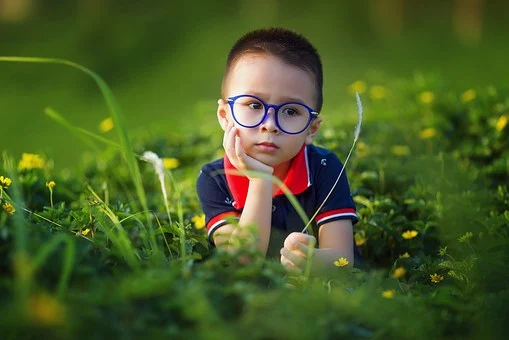Every parent takes extra precautions & care when it comes to children. It’s the age where children can quickly become a victim of many health-related diseases, especially eye problems. That’s why today we can see kids in our neighborhood wearing childrens glasses.
So, it’s crucial to determine the possible issue at the early stage, when vision is still developing, to avoid eye problems.
Possible Symptoms of Eye-Related Issue
Here are some of the symptoms you may be worried about as a parent of your child if noticing any of these issues.
Blinking or Rubbing
Blinking the eyes frequently or rubbing the eyes happens due to irritation caused by pollen-or animal-related allergies. However, these allergies can be treated over-the-counter or using prescription drops. Blinking and rubbing can also indicate stress, anxiety, allergies, or refractive error such as nearsightedness. Therefore, checking your child’s vision with an eye specialist is essential.
White Spots on the Eye
Eye spots can occur for many different reasons, and you need to pay attention to the color & size of the spot.
- Bright Red Spot – A bright red spot, usually a subconjunctival hemorrhage, is a broken blood vessel that can be treated automatically.
- Gray Spot – The gray spot is a condition of a benign condition, which is a sign of the deficiency of iron or anemia.
- Brown Spot – It is usually a nevus or eye freckle that frequently occurs in people with dark hairs or eyes as they naturally produce more melanin.
Large Pupils
Commonly, the children’s pupils appear to be larger than those of adults. Light-colored eyes children tend to have larger pupils.
When the eyes get exposed to the bright light, the pupils should respond to get smaller. If the pupil looks larger than the other, or you are concerned about the child’s pupil reaction, you must consult an ophthalmologist for evaluation.
Seeing Spots in Vision
Suppose your child notices spots or floaters in vision that look like gray or black specks, strings, or cobwebs. Floaters are common in aged people but can occur in children.
Multiple floaters or floaters are accompanied by the flashing light or curtain of vision loss. This may signal a retinal tear or inflammation in the eyes.
Discomfort or Itchiness
Eye discomfort or itchiness is a temporary condition associated with seasonal allergies, and it can cause a tearing, burning sensation, or puffy eyelids. Children are more prone to eye discomfort due to pet dander, dust pollen, smoke, perfumes, and even particular food.
However, if the discomfort is accompanied by redness and sticky or gooey discharge, it may be a sign of viral or bacterial conjunctivitis. Taking your child to an eye doctor to provide treatment is essential. To find the best eye doctor, search for keywords like “eye doctor near me edina” or similar, which can generate a list of top specialists in your area. Check the reviews carefully and book a consultation with the one you feel is the right fit for your child.
In the meantime, you can also have children’s glasses to avoid discomfort at some level while they use a digital screen. .
Sleeping with Open Eyes
It’s common for children’s eyes to open a little bit and move around when they are in a deep sleep. However, there is no harm in this or cause any concern.
But if the children’s eyes are open inside the AC room, the fan is blowing; the eyes are at significant risk of dryness, red, and irritation. An ophthalmologist may suggest drops or ointment to help keep them moist and prevent damage to the cornea.
Crust or Goop in Eyes
Crusty eyes caused due to inflammation in the oil glands of the eyelids, or discharge from the eyes can dry the eyes on the lids and lashes, leading to crusty eyes.
A blocked tear duct is associated with crusty eyes, which occurs when the eye’s drainage system for tears isn’t drained usually or obstructed. It can lead to infected, irritated, or watery eyes. If your child is suffering from such symptoms, you must consult an eye doctor for correct treatment.
Misaligned Eyes
Strabismus is one of the most crucial eye problems that must be treated as soon as possible when the eye turns inward, outward, upward, or downward.
This eye condition can impair vision development as both eyes must aim at the same spot together, leading to weaker vision. Consulting an ophthalmologist can help diagnose the treatment.
Head tilting or Covering.
Several different eye & development conditions cause a child to tilt their head or cover one eye. They try to adjust the angle of vision or increase clarity, which might indicate that the eyes are misaligned, or the child has a lazy eye, called amblyopia. This is a possible sign of refractive error.
Many children turn their face side to make their vision clearer, known as astigmatism. Children with nearsightedness look at the object with their chin-ups to get a clear vision. While on the other hand, the farsighted children chin down to focus on the objects to make them explicit. However, you can buy medical eye patches to help treat the problem or get children glasses online as the eye doctor prescribes to make the thing clearer.
Conclusion
The eyes are the most sensitive part of the body that needs special care, especially for children.
As a parent, you must observe your child’s eye, and if you find any eye-related issue, you must consider consulting an ophthalmologist for the treatment. If the doctor recommends using eyewear for your kids, it is crucial to get one as soon as possible to prevent vision loss.
For this, you can buy children glasses online from a variety of reputable companies, which deal in top quality frames and prescription glasses of superior quality. Moreover, using the latest technology of Blue cut lenses, all the eyewear helps protect the eyes from UV and blue rays.
